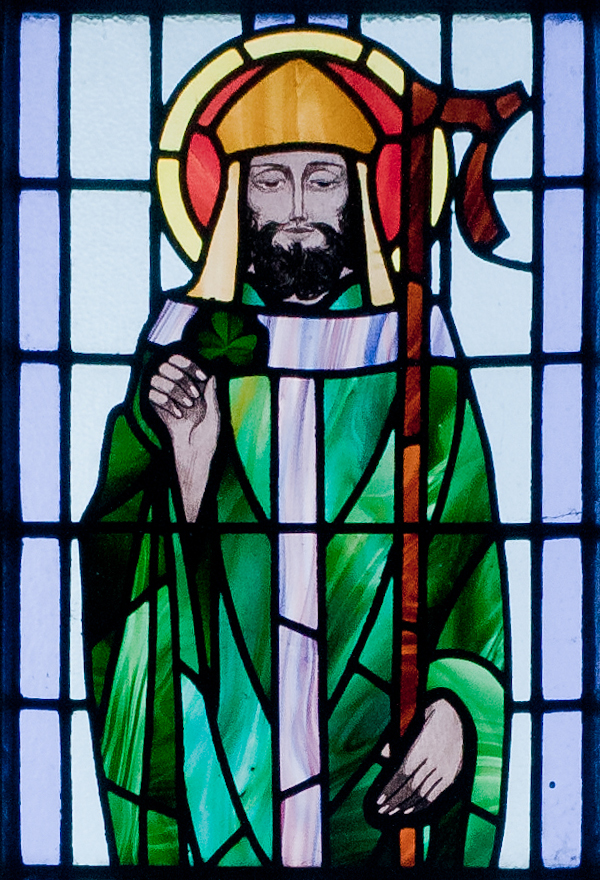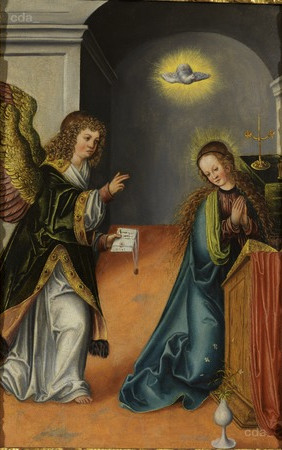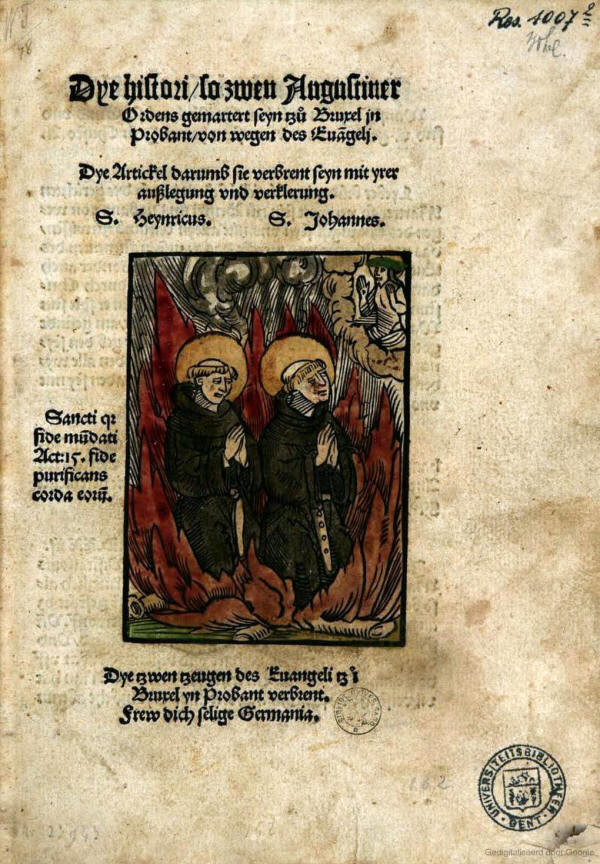During the season of Lent the Church still remembers those who went before and those important events in the life of our Lord. March includes a large variety, including Old and New Testament saints as well as both well known and lesser known early Church saints and one of the principal feasts of Christ. Read this to learn more about our sombre celebrations during March.
March 7: Perpetua and Felicitas, Martyrs

Vivia Perpetua (c. 182 – c. 202) and Felicitas (? – c. 202), were North African martyrs put to death for their faith by the decree of Septimius Severus (r. 193-211). The difference between the lives of these two martyrs up to their deaths could not have been greater. Perpetua was from a noble and wealthy family in Carthage and enjoyed many of the privileges which went along with it, including a liberal education. She had a respectable marriage and had an infant son. Felicitas, on the other hand, was a slave who was pregnant. However different these women were, they shared a love of Christ and would die as witnesses for Him together as sisters. In the time leading up to their execution, Perpetua gave her son into the care of her brother (who was also a Christian), and Felicitas gave birth and was able to have a member of her congregation take her daughter to raise in the faith. These two women, steadfast in the faith, were publicly executed before the crowds in honour of the Emperor’s birthday, first facing wild beasts, and finally being killed by the sword. One of the most moving images from the account of their martyrdom recalls that when they were brought out a second time into the arena, the two women of such different stature and already injured from the wild beasts, greeted each other with the kiss of peace. In these two our God has given us examples of steadfastness under trial, that His strength is demonstrated in weakness, and that no matter our backgrounds all Christians are brothers and sisters and equal heirs of salvation.
Precious in the eyes of the Lord is the death of his favored ones
Psalm 116:15
March 17: Patrick, Missionary to the Irish

Patrick (c. 385 – March 17, 461), was a Roman-British pastor and missionary to the Irish people. While Patrick’s family was Christian, he did not take the faith seriously in his youth or think of himself as a Christian. When he was sixteen he was captured by pagan Irish pirates and was enslaved for six years. During his time of captivity, Patrick turned to the God of his fathers whom he had previously dismissed, and came to a repentant faith in Christ. When he returned to Britain, Patrick immersed himself in the study of the faith and was eventually ordained. After this he returned to the land of his captivity, moved by love for the people of Ireland and wanting to share with them the Gospel of Christ that they might be set free from slavery to sin. The Lord worked wonderfully through Patrick, bringing many to faith in Christ so that multitudes from the rich to the poor, and from peasants to princes believed. The legend of Patrick driving the snakes from Ireland is most likely symbolic of his work driving paganism from the island through the preaching of Christ. He is remembered as one of the great missionaries to the nations because God used Patrick to bring Christianity to the Irish people, who would in turn, would send missionaries throughout many places in Europe still under the shadow of sin and death. His life also shows us an example of the love we are to have for our enemies, and for that, we give thanks to God that He had given him this great love, and pray that He would grant it to us as well.
[Jesus said,] “You have heard that it was said, ‘Love your neighbor and hate your enemy.’ But I tell you, love your enemies and pray for those who persecute you, so that you may be children of your Father who is in heaven.”
Matthew 5:43-45a
March 19: St. Joseph, Guardian of Jesus

St. Joseph (1st century BC – 1st century AD) was the husband of the Blessed Virgin Mary, and the legal father of our Lord and Saviour Jesus Christ. While Joseph is not the biological father of Jesus, God used Joseph for His purposes in bringing salvation through His Son. While “guardian” brings to mind “legal guardian” for us today, the title is telling us more, and really speaks to how God used Joseph. As the guardian of Jesus, Joseph was a shield from scandal for our Lord as He was conceived of a virgin. Many could use this as a way to insult Him during His life and dismiss His ministry by making improper assumptions or accusations of His parentage. As the guardian of Jesus, Joseph is the legal father and provides Jesus with the legal descent from David, making Him the Son of David which fulfils the promises God made to David. As the guardian of Jesus, Joseph would have helped to raise Jesus and teach to Him the faith, and his trade. Joseph is present at the early events of our Lord’s life up to when He stays at the Temple after Passover while His family returns to Nazareth (Luke 2:41-50), but does not appear after this. This probably contributes to the tradition that Joseph was already older when he was betrothed to Mary, as he is not present at all in Jesus’ ministry, His death, or after His resurrection. Yet, Joseph faithfully fulfilled his calling as Jesus’ guardian and so today we thank God for him, and pray for all fathers and those who act as fathers for the fatherless.
This is how the birth of Jesus Christ took place. His mother, Mary, was pledged in marriage to Joseph. Before they came together, she was found to be with child by the Holy Spirit. Joseph, her husband, was a righteous man and did not want to disgrace her. So he decided to divorce her privately. But as he was considering these things, an angel of the Lord suddenly appeared to him in a dream and said, “Joseph, son of David, do not be afraid to take Mary home as your wife, because the child conceived in her is from the Holy Spirit. She will give birth to a son, and you are to give him the name Jesus, because he will save his people from their sins.”
Matthew 2:18-21
March 25: The Annunciation of our Lord

Nine months before Christmas, the Church celebrates the Annunciation of our Lord, when the angel Gabriel appeared to the Virgin Mary to announce that she would conceive and bear a son (Luke 1:26-28). This is celebrated as one of the principal feasts of Christ because it is an important event in His earthly life. While it may seem that we got this date by counting backwards from Christmas, it is actually the opposite! The early Church celebrated the Annunciation first, and only later was Christmas added by going forward nine months. The timing of this day comes from an old belief that important people would have perfect ages, that is, they would die on the day of their conception. This feast was then calculated based on when Jesus died. Because of this the Annunciation happens during Lent, and it gives us a small respite from our solemn season to celebrate the conception of our Lord Jesus who would die for our sins. The Annunciation helps us remember that our Lord Jesus went through all the experiences of human life, including where life begins: conception. It also gives us encouragement to pray for and stand up for the voiceless and helpless, including the unborn, for our Lord Himself was once one such one when the incarnation began.
The angel went to her and said, “Greetings, you who are highly favored! The Lord is with you. Blessed are you among women.” But she was greatly troubled by the statement and was wondering what kind of greeting this could be. The angel said to her, “Do not be afraid, Mary, because you have found favor with God. Listen, you will conceive and give birth to a son, and you are to name him Jesus. He will be great and will be called the Son of the Most High. The Lord God will give him the throne of his father David. He will reign over the house of Jacob forever, and his kingdom will never end.”
Luke 1:28-33
March 31: Joseph, Patriarch

Joseph (c. 1914 – c. 1804 BC) was the son of Jacob by his favoured wife Rachel. The life of Joseph is the main focus of the last section of Genesis from chapter 37 on. Joseph himself is a type of Christ, that is, his life prefigures that of our Lord and Saviour Jesus Christ. His brothers betrayed him, selling him into slavery in Egypt, while telling their father that he was killed by a beast. However, from this, he is figuratively brought back to life again when he reveals himself to his brothers when they come to Egypt for aid during a famine. Thus, he pointed forward to the betrayal, death, and resurrection of our Lord. As a son of Jacob, one would expect for there to be a tribe of Joseph, as there are with all of Jacob’s 11 other sons. However, there is none. Instead, his two sons Manasseh and Ephraim, born to him by his Egyptian wife Asenath, become two “half tribes” in his place when Joseph asks his father to bless them. Joseph also has a number of events in his life which shine as examples to the faithful. First, as a slave, he resisted the wife of Potiphar who tried to seduce him and was willing to suffer the consequences of doing so, so that he would rather suffer doing right rather than sin (Genesis 39). He also gives an example to us of forgiveness as he forgives his brothers who sold him into slavery and reconciles with them (Genesis 50:15-21).
His brothers also came and fell down in front of him, and they said, “See now, we are your servants.” Joseph said to them, “Do not be afraid, for am I in the place of God? You meant evil against me, but God meant it for good, to bring this to pass and to keep many people alive, as it is this day. Now therefore, do not be afraid. I will nourish you and your little ones.” He comforted them and spoke to them in a kind way.
Genesis 50:18-21
